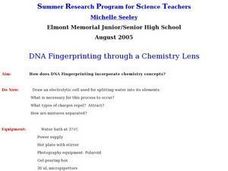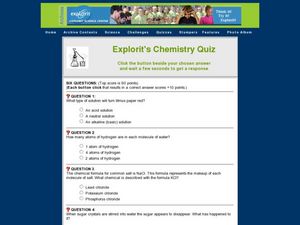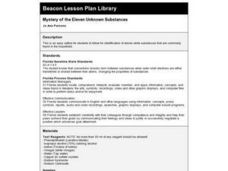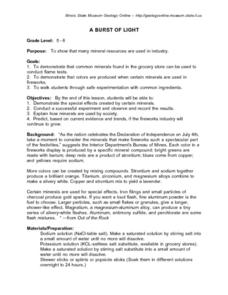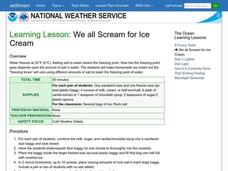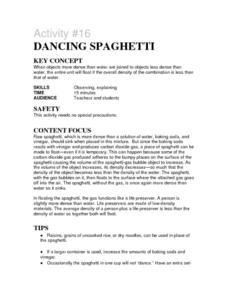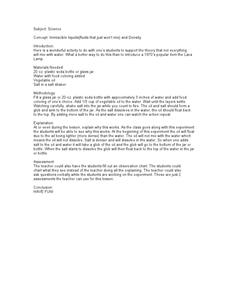Curated OER
DNA Fingerprinting through a Chemistry Lens
Students explore DNA and restriction enzymes using fragments of DNA separated by electrophoresis on an agarose gel. They analyze the results to see "whodunit".
Curated OER
New Jersey Estuaries Water Filter Activity
Students examine how an estuary's plants and soil filter water before it flows into the ocean. They complete a lab report drawing and writing about what they observe after completing a water filter activity.
Curated OER
ISOLATION OF DNA FROM ONION
Students perform a lab in which they extract DNA from onion cells. Students break through the cell and nuclear membranes and then break down the protein that the DNA is wrapped around.
Curated OER
Explorit's Chemistry Quiz
In this chemistry worksheet, students complete a six question multiple choice quiz about chemistry. This is an on-line interactive worksheet.
Curated OER
Ground Level Ozone Testing
Students prepare Shoenbein Paper to test the ground level of ozone. They dip a strip of their test paper in distilled water and hang it at a data collection site. They determine the relative humidity of the data collection site. Using a...
Curated OER
DNA Extraction From Living Things
Students extract DNA from split peas. In this biology lesson, students hypothesize what DNA looks like and perform the experiment to verify their hypothesis. They explain the importance of DNA in living things.
Curated OER
Food and Fiber: Helping the Environment and You
Fourth graders explore the many uses of corn-based products and the importance of water resources. They consider how biodegradable products help to keep water clean. They perform experiments to observe how corn pellets dissolve while...
Curated OER
Physical vs. Chemical Change Lab
Students recognize both a physical and chemical change in different substances. They determine which particles actually changed into different substances, and explain if it represented a physical or a chemical change.
Curated OER
Striking it Rich with Chemistry
Young scholars identify the composition of different pennies. In this chemistry lesson plan, students use a post 1982 penny to observe chemical change. They explain how to turn a penny from copper to gold.
Curated OER
What Does That DNA Molecule Really Look Like???
Students extract DNA from animal liver cells. They separate, collect and describe the appearance from the extracted DNA while role playing as an intern in a city's forensics.
Curated OER
Our Food and Microorganisms
Students answer questions about how microorganisms can affect our food supply and how they can be controlled. The first set of inquiry activities are directed by the teacher. Subsequent activities are based on students generating their...
Curated OER
Wood Types/Porosity
Students examine hardwoods and their pores. They discover that some pores allow for air movement while others do not. They also examine and identify the different types of hardwoods.
Curated OER
Water Chemistry
Students engage in a lesson that is concerned with the concept of water chemistry. They conduct research using a variety of resources. Students also consider an experiment to observe how water has the abiility to exist as three different...
Curated OER
Mystery of the Eleven Unknown Substances
Fourth graders identify eleven white substances that are commonly found in the household. They, in pairs, perform experiments on a variety of substances, and must identify them based on the reactions they observe.
Curated OER
A Burst of Light
Students discover the many uses of minerals in industry. They use minerals to conduct flame tests and to demostrate color. They practice safety tips in the lab.
Curated OER
We All Scream for Ice Cream
Pupils make ice cream while experimenting with the freezing point of water. They experiment with different amounts of salt.
Curated OER
Activity #16 Dancing Spagehetti
Learners experiment with floating the spaghetti, the gas functions like a life preserver. Pupils comprehend that a person is slightly more dense than water. They comprehend that a life preservers are made of low-density materials. The...
Curated OER
Immiscible Liquids and Density
Students will make a lava lamp. In this density instructional activity, students will combine water and oil and make observations, then add salt to the oil and observe the oil sink, then float again when the salt dissolves in the water.
DiscoverE
Slime!!
Who's going to get slimed? Your entire class! Scholars create slime using Borax, water, and white glue. Some food coloring can give the slime a bit of color.
Curated OER
How Does Water Cool?
How fast does water cool? First fifth graders will draw a line on a graph that predicts how fast they think water can cool from boiling. Then they plot the actual data on the same graph to see if their estimate was correct.
Aiken County Public Schools
Claymation in the Classroom
Students design an appropriate and usable storyboard and then create a claymation video. They take digital photographs frame by frame, then assemble the stop-motion movie using video software.
TED Talks
Ted: Ted Ed: Science of Macaroni Salad: What's in a Mixture?
What's in macaroni salad? Break down the pasta, mayonnaise, vinegar, mustard, vegetables, etc., and you're left with a bunch of molecules. Josh Kurz uses a delicious recipe to exemplify three types of mixtures (solution, colloid and...
Georgia Department of Education
Ga Virtual Learning: Chemistry: Solutions
In this module, students study solutions; how they are formed, how to calculate concentration of solutions, and what the colligative properties of solutions are.
CK-12 Foundation
Ck 12: Fifth Grade Science: Physical Science: Separating Mixtures
[Free Registration/Login may be required to access all resource tools.] Discusses how mixtures of solids can be separated based on observable properties of their parts such as particle size, shape, color, and magnetic attraction.


